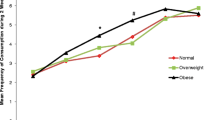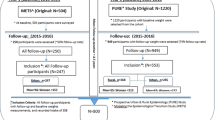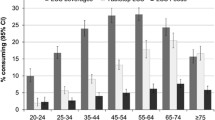Abstract
The objective of the study was to assess the relations of socioeconomic and behavioral factors to frequent consumption of sugar-sweetened soda among New York City (NYC) adults and the relation of frequent consumption to body mass index (BMI; kg/m2). Data from the 2005 NYC Community Health Survey, a population-based telephone survey, were analyzed. Frequent consumption was defined as drinking one or more 12-oz servings of sugar-sweetened soda on an average day; 9,865 adults, aged 18 years and older, provided valid responses. Logistic regression was used to identify factors associated with frequent consumption, and linear regression models were used to assess the relation of frequent consumption to BMI. An estimated 27.5% of NYC adults are frequent sugar-sweetened soda consumers. Frequent consumption is independently associated with low household income (odds ratio [OR] = 1.7, 95% confidence interval [CI] 1.4–2.1 for <200% vs. ≥600% federal poverty level) and with ethnic group and nativity (e.g., OR = 3.1, 95% CI 2.6–3.7 for U.S.-born blacks vs. whites). Men report more consumption then women, but an association of less education with frequent consumption is stronger among women. Adjusting for demographics, frequent consumption is associated with more television viewing and with less physical activity. Adjusting for demographics and behaviors, frequent consumption was associated with higher BMI among women (0.7 BMI units, 95% CI 0.1–1.2) but not among men. Disparities in sugar-sweetened soda consumption mirror obesity disparities. Improved surveillance and interventions are needed to better quantify and reduce consumption of sugar-sweetened beverages, especially in groups most impacted by obesity.
Similar content being viewed by others
References
Mokdad AH, Ford ES, Bowman BA, et al. Prevalence of obesity, diabetes, and obesity-related health risk factors, 2001. JAMA. 2003;289(1):76–79.
Mokdad AH, Serdula MK, Dietz WH, Bowman BA, Marks JS, Koplan JP. The spread of the obesity epidemic in the United States, 1991–1998. JAMA. 1999;282(16):1519–1522.
EpiQuery: New York City Interactive Health Data. Community Health Survey, 2006 data. New York City Department of Health and Mental Hygiene web site. Accessed on: January 6, 2008. Available at: http://query1.health.nycnet/query/index.html.
Must A, Spadano J, Coakley EH, Field AE, Colditz G, Dietz WH. The disease burden associated with overweight and obesity. JAMA. 1999;282(16):1523–1529.
Flegal KM, Graubard BI, Williamson DF, Gail MH. Excess deaths associated with underweight, overweight, and obesity. JAMA. 2005;293(15):1861–1867.
Adams KF, Schatzkin A, Harris TB, et al. Overweight, obesity, and mortality in a large prospective cohort of persons 50 to 71 years old. N Engl J Med. 2006;355(8):763–778.
Sturm R. The effects of obesity, smoking, and drinking on medical problems and costs. Health Aff (Millwood). 2002;21(2):245–253.
Nielsen SJ, Popkin BM. Changes in beverage intake between 1977 and 2001. Am J Prev Med. 2004;27(3):205–210.
Bray GA, Nielsen SJ, Popkin BM. Consumption of high-fructose corn syrup in beverages may play a role in the epidemic of obesity. Am J Clin Nutr. 2004;79(4):537–543.
Popkin BM, Duffey KJ. Adults with healthier dietary patterns have healthier beverage patterns. J Nutr. 2006;136(11):2901–2907.
Mostashari F, Kerker BD, Hajat A, Miller N, Frieden TR. Smoking practices in New York City: the use of a population-based survey to guide policy-making and programming. J Urban Health. 2005;82(1):58–70.
U.S. Department of Health and Human Services. Healthy People 2010, with Understanding and Improving Health and Objectives for Improving Health, 2nd edn. Washington, DC: U.S. Government Printing Office; 2000 (2 vols.).
Borders TF, Rohrer JE, Cardarelli KM. Gender-specific disparities in obesity. J Community Health. 2006;31(1):57–68.
Zhang Q, Wang Y. Socioeconomic inequality of obesity in the United States: do gender, age, and ethnicity matter? Soc Sci Med. 2004;58(6):1171–1180.
SAS Institute. SAS, Version 9.1. Cary, NC: SAS Institute; 2003.
Research Triangle Institute. SUDAAN. SAS-Callable Version 9.0. Research Triangle Park, NC: Research Triangle Institute; 2004.
Carnethon MR, Lynch EB, Dyer AR, et al. Comparison of risk factors for cardiovascular mortality in black and white adults. Arch Intern Med. 2006;166(11):1196–1202.
Miech RA, Kumanyika SK, Stettler N, Link BG, Phelan JC, Chang VW. Trends in the association of poverty with overweight among U.S. adolescents, 1971–2004. JAMA. 2006;295(20):2385–2393.
Blakely F, Dunnagan T, Haynes G, Moore S, Pelican S. Moderate physical activity and its relationship to select measures of a healthy diet. J Rural Health. 2004;20(2):160–165.
Graham R, Kaufman L, Novoa Z, Karpati A. Eating In, Eating Out, Eating Well: Access to Healthy Food in North and Central Brooklyn. New York, NY: New York City Department of Health and Mental Hygiene; 2006.
Liebman M, Pelican S, Moore SA, et al. Dietary intake, eating behavior, and physical activity-related determinants of high body mass index in rural communities in Wyoming, Montana, and Idaho. Int J Obes Relat Metab Disord. 2003;27(6):684–692.
French SA, Jeffery RW, Forster JL, McGovern PG, Kelder SH, Baxter JE. Predictors of weight change over two years among a population of working adults: the Healthy Worker Project. Int J Obes Relat Metab Disord. 1994;18(3):145–154.
Schulze MB, Manson JE, Ludwig DS, et al. Sugar-sweetened beverages, weight gain, and incidence of type 2 diabetes in young and middle-aged women. JAMA. 2004;292(8):927–934.
Sorensen LB, Raben A, Stender S, Astrup A. Effect of sucrose on inflammatory markers in overweight humans. Am J Clin Nutr. 2005;82(2):421–427.
Tordoff MG, Alleva AM. Effect of drinking soda sweetened with aspartame or high-fructose corn syrup on food intake and body weight. Am J Clin Nutr. 1990;51(6):963–969.
Nawaz H, Chan W, Abdulrahman M, Larson D, Katz DL. Self-reported weight and height: implications for obesity research. Am J Prev Med. 2001;20(4):294–298.
Warner M. Soda sales fall for first time in 20 years. The New York Times. March 9, 2006.
Acknowledgments
The authors thank Dr. Bonnie Kerker for her thoughtful review of the manuscript. The authors are also grateful to Ms. Donna Eisenhower and Chitra Ramsaswamy for oversight of the collection and management of the Community Health Survey data. The authors have no competing interests related to this work. The Community Health Survey data collection and this analysis were solely funded internally by the Department of Health and Mental Hygiene.
Author information
Authors and Affiliations
Corresponding author
Rights and permissions
About this article
Cite this article
Rehm, C.D., Matte, T.D., Van Wye, G. et al. Demographic and Behavioral Factors Associated with Daily Sugar-sweetened Soda Consumption in New York City Adults. J Urban Health 85, 375–385 (2008). https://doi.org/10.1007/s11524-008-9269-8
Received:
Accepted:
Published:
Issue Date:
DOI: https://doi.org/10.1007/s11524-008-9269-8




